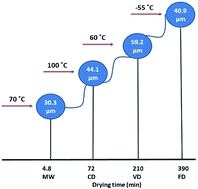Influences of novel microwave drying on dissolution of new formulated naproxen sodium
Abstract
Drying of a pharmaceutical composition is an important step during its processing, which can affect its quality attributes including its texture, dispersion of the drug within the formulation, drug dissolution kinetics and eventually the drug's efficacy. This study presents the influence of varying drying techniques on the textural properties of the wet granulated formulation consisting of the drug naproxen sodium (NapSod) during the drying process. A new pharmaceutical formulation consisting of the NapSod drug was prepared by wet granulation and dried by novel microwave drying (MW), freeze drying (FD), vacuum drying (VD), and convective drying (CD) techniques before being processed in the form of tablets. The dissolution rate of NapSod from the tablet was measured in gastric (pH = 1.3) and intestinal fluid (pH = 6.8) mediums. The drug release was found to be influenced by the specific surface area, size distribution and the crystalline structure of dried particles, which were found to vary with the type of drying technique used as confirmed by the results of XRD, FTIR, SEM and particle size analyses. This study shows that using microwave technique to dry pharmaceutical granules containing a polar drug, such as NapSod, is an efficient and economical process, which can maintain the drug release at an appropriate rate to realize its desired pharmaceutical effect.



 Please wait while we load your content...
Please wait while we load your content...